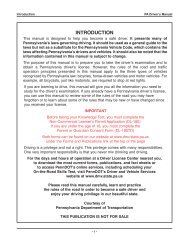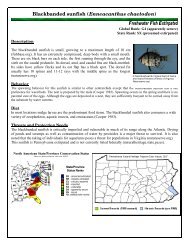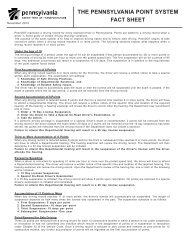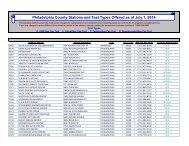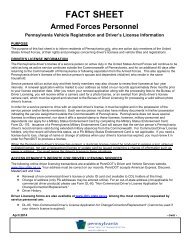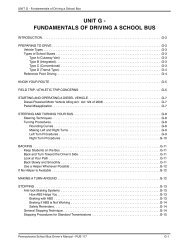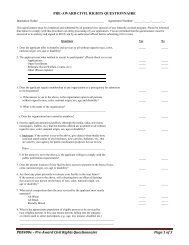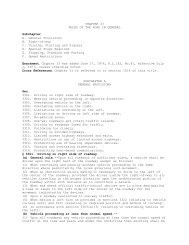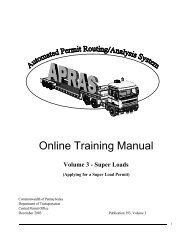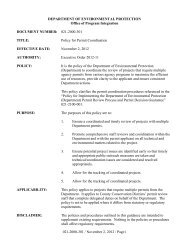PennDOT - Hazardous Materials Endorsement Renewal Manual
PennDOT - Hazardous Materials Endorsement Renewal Manual
PennDOT - Hazardous Materials Endorsement Renewal Manual
Create successful ePaper yourself
Turn your PDF publications into a flip-book with our unique Google optimized e-Paper software.
If hazardous materials are spilling from your vehicle, do not move it any<br />
more than safety requires. You may move off the road and away from places<br />
where people gather, if doing so serves safety. Only move your vehicle if you<br />
can do so without danger to yourself or others.<br />
Never continue driving with hazardous material leaking from your vehicle in<br />
order to find a phone booth, truck stop, help or similar reason. Remember,<br />
the carrier pays for the cleanup of contaminated parking lots, roadways and<br />
drainage ditches. The costs are enormous, so don't leave a lengthy trail of<br />
contamination. If hazardous materials are spilling from your vehicle:<br />
• Park it.<br />
• Secure the area.<br />
• Stay there.<br />
• Send someone else for help.<br />
When sending someone for help, give that person:<br />
• a description of the emergency.<br />
• Your exact location and direction of travel.<br />
• Your name, the carrier's name and the name of the community or city<br />
where your terminal is located.<br />
• The proper shipping name, hazard class and ID number of the<br />
hazardous materials, if you know them.<br />
This is a lot for someone to remember. It is a good idea to write it all down<br />
for the person you send for help. The emergency response team must know<br />
these things to find you and to handle the emergency. They may have to<br />
travel miles to get to you. This information will help them to bring the right<br />
equipment the first time, without having to go back for it.<br />
Never move your vehicle, if doing so will cause contamination or damage<br />
the vehicle. Keep downwind and away from roadside rests, truck stops,<br />
cafes and businesses. Never try to repack leaking containers. Unless you<br />
have the training and equipment to repair leaks safely, don't try it. Call your<br />
dispatcher or supervisor for instructions and, if needed, emergency<br />
personnel.<br />
RESPONSES TO SPECIFIC HAZARDS<br />
CLASS 1 (EXPLOSIVES)<br />
If your vehicle has a breakdown or accident while carrying explosives, warn<br />
others of the danger. Keep bystanders away. Do not allow smoking or open<br />
fire near the vehicle. If there is a fire, warn everyone of the danger of<br />
explosion.<br />
Remove all explosives before separating vehicles involved in a collision.<br />
Place the explosives at least 200 feet (61m) from the vehicles and occupied<br />
buildings. Stay a safe distance away.<br />
- 32 -



